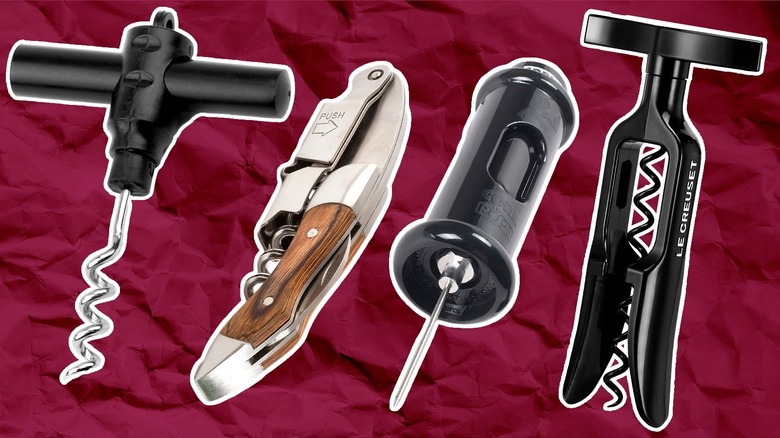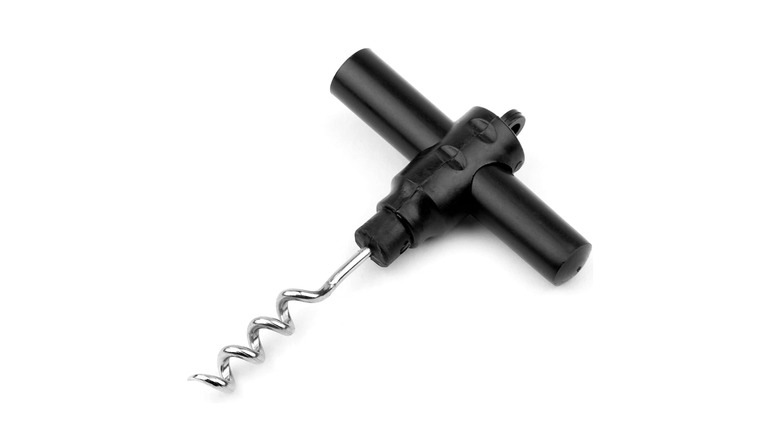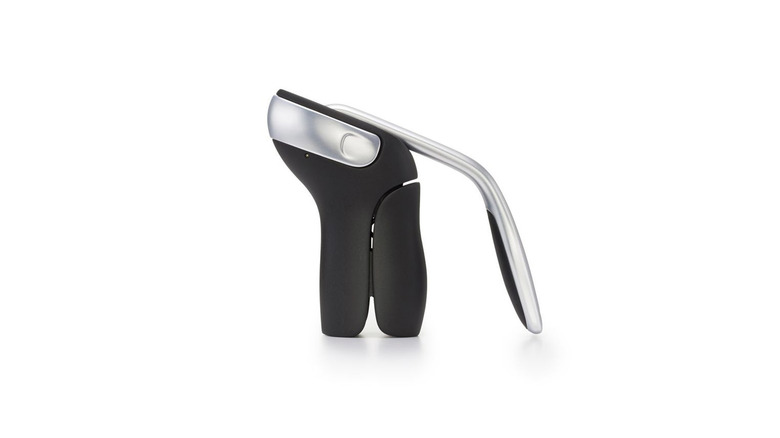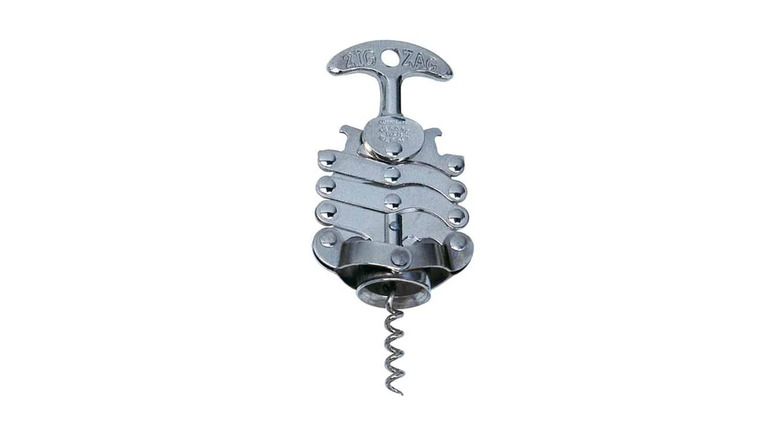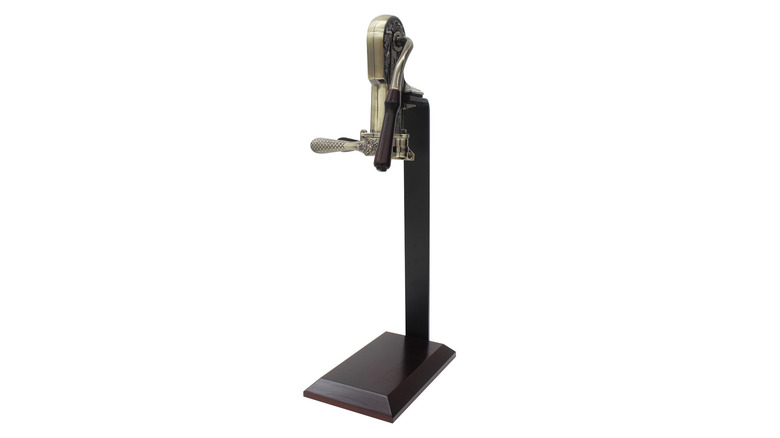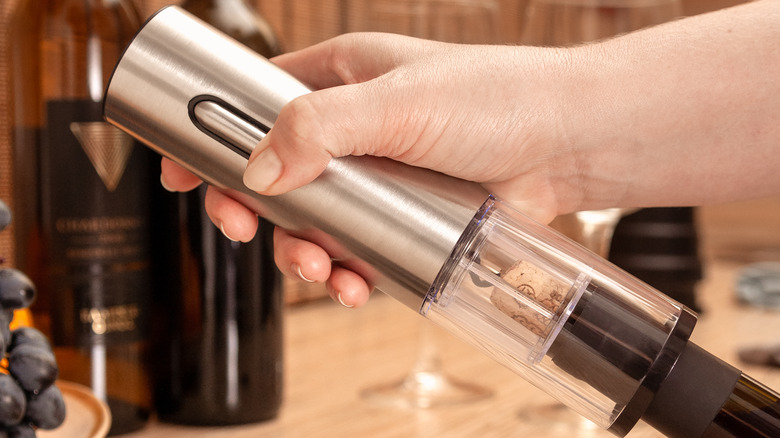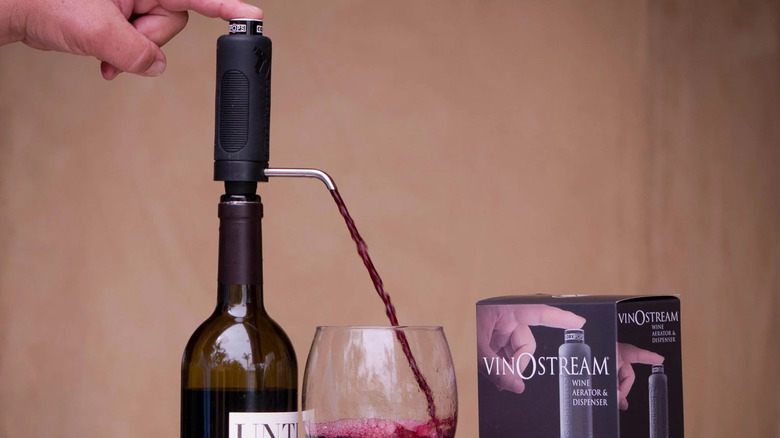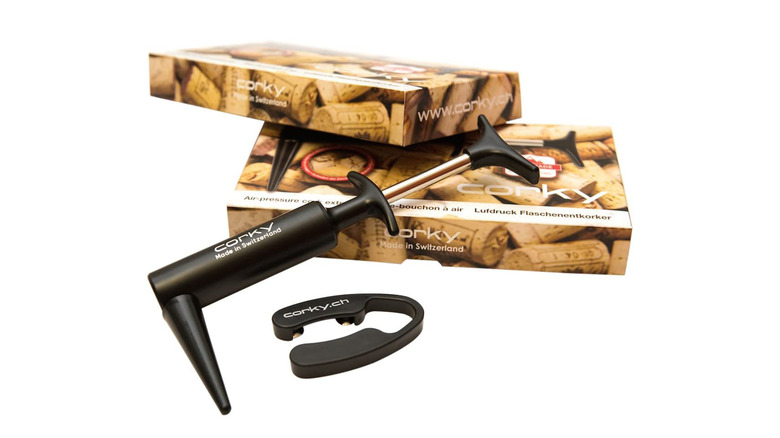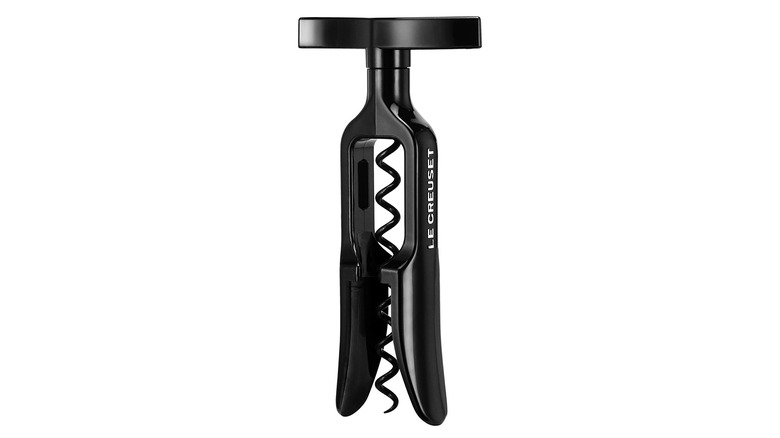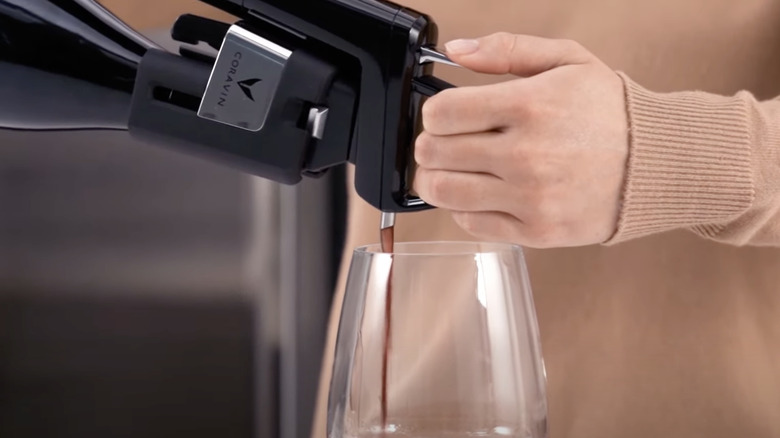13 Types Of Corkscrews And Other Wine Openers, Explained
We may receive a commission on purchases made from links.
If you think about it, corkscrews don't get as much credit as they deserve. According to Vinepair, the old world bottle opener has been handily unleashing alcoholic concoctions since the 1680s. From its wooden-handled origins, to the double lever-winged improvement of later iterations, the corkscrew has only become more efficient. Even as bottle caps have advanced beyond an actual need for corks, a screw-on doesn't quite replace the satisfying experience of popping one out.
Uncorking wine carries with it a feeling of class, with everything from the remnants of red wine stained upon the cork to the small cloud of mist that escapes, followed by the pleasure of the first pour. Corkscrews are fairly straightforward tools, you simply position them in the center of the cork, then screw and pull. It takes no more than a minute, and even less time depending on what type of corkscrew you use. Lower-priced models will get the job done just fine, but can sometimes damage the cork itself. Trust us, trying to open wine without a corkscrew is a harder challenge than anyone deserves to randomly face.
That said, if there's anything you can learn from the history of corkscrews, it's that no matter what, humans will find a way to get to their beloved wine. Whether planning a romantic picnic outing, or hosting an important dinner party, enjoyment is only a corkscrew away. To keep you prepared for any wine-friendly occasion, here's a list of the many types of corkscrews and other wine openers.
Pocket corkscrews are mobile-friendly
History's first humble corkscrew was wooden-handled and didn't include the additional lever functions common to today's varieties. One type that still retains the single direction twist function of the OG is the plastic and portable corkscrew, which was made to fit perfectly in your pocket. Adding to its list of qualities, pocket corkscrews are also cheap, easy to find in a pinch, and come in a wide range of colors. They have a modular design that allows the handle to double as a sheath for the worm screw, reducing them to pocket-friendly length. Despite being made of plastic, they're generally durable under pressure — although we'd never recommend using one in a wine uncorking contest.
The only screwy part about pocket corkscrews is that they require a bit of elbow grease. Without additional lever functions, you'll only get to the goods with a bit of manual labor. Not to worry though, it's easy, all you have to do is pull and shimmy, then pull and shimmy some more until it pops out. With a pocket corkscrew, you can celebrate on the go.
Waiter's corkscrews are affordable and functional
Following the success of the original single direction twist corkscrew, a German wine-lover named Carl F.A. Wienke took it upon himself to reinvent the wheel. Keeping all of the features that have worked for years, Wienke took inspiration from a pocket knife and added a foldable function, thus creating the "Waiter's Friend." Other popular names are "Butler's Friend," "Wine Key," and even the "Sommelier's Knife," which of course comes from "pocket knife." That's why you'll usually find them with additional features, like a bottle opener and foil cutter.
With a foldable upgrade, the Waiter's Friend can leverage against the sides of the wine bottle, assisting you by pushing in the opposite direction to your pull. In other words, less shimmy is required. Like pocket corkscrews, these are also affordable and common go-tos. Waiter's corkscrews are just as portable, and also more efficient, but make no mistake about it, both are effective uncorking tools. It really boils down to how much you wanna grease your elbows, and how much free pocket space you have.
Reduce breakage with winged corkscrews
Corkscrews really flew to new heights with the creation of the double-lever, rack-and-pinion "Wing Corkscrew." According to Vinepair, it was first patented in 1888 by a man named H.S. Heely. Slowly, the tales of its uncorking exploits began to spread across the globe, popping up in the United States by 1930, before continuing on to become the common household essential it is today. The wing corkscrew revolutionized the original, providing a function that alleviated much of the usual manual labor. It's honestly one of the best corkscrews — period.
Rather than having to rely on pulling, the wing corkscrew does the pulling for you. It works using a pair of levers that rise as you screw further into the cork. Once you've screwed deep enough, the levers stick up to form a T shape. Using both hands, or one if you're a wine-opening wiz, push down on the levers to pull the cork up. As the cork rises, it's secured by a cork-shaped cage, which provides support as you pull, reducing the chances of breakage.
Lever corkscrews require no arm strength
The next level up in corkscrew technology takes the wing-approach that uses a lever to help remove the cork, and makes it even more efficient. Lever corkscrews are operated using a grip and handle function. Fastening around the neck of wine bottles, its secure grip allows for easy uncorking. All you have to do is press down the handle to insert the screw tip into the cork, then lift it back up for a hassle-free removal. They're also referred to as the "Rabbit" corkscrew, which is actually a specific brand that helped popularize them. Even outside of the brand, many iterations have an unmistakable rabbit-like design too.
Though generally pricier than other models, if you're a wine connoisseur, lever corkscrews are a must-have. They're sleekly designed, secure, drip-free, and only require two steps. You can find more budget-friendly types made of plastic, or professional grade ones made of stainless steel. Of course, quality and grip comfortability will vary. Either way, lever corkscrews are a worthy investment, trust us, you'll have no worries to wine about.
Fancily remove corks with a classic zig-zag opener
Sure to take you on a few twists and turns, the Zig-Zag corkscrew is easily one of the most unique styles. A French invention, according to Collection privée tire-bouchons, its creator Jules Bart registered the patent in 1919. Many advancements would be made in the years that followed. Aside from its unmistakable zig-zag design, the word itself is typically imprinted on each side of the pulling handle — although that isn't always the case.
This accordion-style tool is less common nowadays, mostly used at special wine bars or by dedicated wine enthusiasts. The zig-zag kind is also a bit pricey like the lever corkscrew. Its metal plated or stainless steel varieties are both built sturdily. You definitely won't find these amazing contraptions in plastic. In addition to being an uncorking beast, these retro babies can remove beer caps too. Whip it out at your next dinner party and impress guests with historical tidbits and efficient wine opening.
Mounted wine openers makes uncorking quick and easy
These large contraptions are primarily used at restaurants or establishments where wine is served. Mounted wine openers are lightning fast, delicate, and precise enough to remove corks cleanly and re-cork bottles when ready. According to the Wine History Project, while records exist showing they've been around since the 1800s, many iterations have been patented around the world. As such, mounted wine openers come in lots of shapes and sizes.
They're usually on the costly side, ranging from $60 on the low end to more than $100 on the high. A fancy one can run you even more. That's why you're likely to only find them in the homes of serious connoisseurs who wax "wine-etics" often. If that resonates with you, and you're looking to up your corkscrew game, the first thing you need is counter space. Although mounted wine openers don't take up a ton of space, the amount can vary depending on what type you have. You'll want to have at least 10 inches of available counter space to comfortably mount and use your corkscrew. If you have limited room, there are even some types that you can mount to your wall.
Use twin blade wine openers for vintage bottles
One of the perks of wine is its ability to shape-shift with time. While most wines are made to be enjoyed right away, others benefit from aging, developing their own particular flavor profile. That's why younger wines tend to be bitter and astringent, whereas aged ones are aromatic and full-bodied. Of course, the reward of elevated taste comes with a caveat: brittle corks. As corks age, they naturally become more fragile and prone to breakage. That's why twin blade wine openers are better for old bottles.
Twin blade, also known as two prong, wine openers are made specifically for preventing corkscrew pieces from dropping into your libation. Unlike a corkscrew, the twin blade opener was designed to cleanly slip between the cork and bottle, allowing you to carefully lift and remove it without damaging its structural integrity. After all, who wants to wait years just to sip on a cork-filled vintage? Corks can also be reused when they're left intact. To put a pretty bow on it, if you're a wine lover, you need this tool to open bottles.
Save time with an electric corkscrew
If there's anything you can say about humans, it's that we enjoy having to do less work. Convenience is a luxury of necessity, making things easier, faster, and better. At its core, it fulfills a basic need, but does so with style. Electric Wine Bottle Openers are a great example of convenience. They effectively reduce the act of uncorking to two effortless steps: positioning the corkscrew and pressing a button. Impressively, some don't even require a button.
Some are battery-powered while others need recharging, yet all only require one hand to use. Unsurprisingly, electric wine bottle openers are pricier than manual corkscrews, but many also come with warranties, so they'll be more than enough wine opening to go around. Depending on the brand you purchase, one fully charged battery is good for uncorking 30 to 80 wine bottles. The ease of use also makes it the best corkscrew option for those with limited range of hand and body motion.
Cork Pops relieve the pressure of wine opening
If there's any take away from the long history of corkscrews, it's that people have been trying to reduce or remove the act of screwing altogether since the tool's inception. One invention that succeeded is the Cork-pop. It's a fairly recent invention according to Missouri Wine; compared to others, it's only been around since the 1960s. Fitted with a low-pressure carbon dioxide cartridge, the cork-pop inserts a hollow needle into the cork and releases a burst of gas that forces it out.
For some people, corkscrews can be challenging to use because they require gripping and twisting. Cork-pops are great for wine lovers that need a bit of help with uncorking. Another great thing about them is the price, which is super affordable by comparison to screw and pull types — a single cartridge will open between 60 to 80 bottles. You should be able to easily find one at your local grocery or beverage store.
No need to twist and pull with an air pump
Another screwless corkscrew variety is the air pump opener. It's one of the newest corkscrew inventions in the game and replaces the screwing function with air pumping technology. We're pretty certain the great corkscrew inventors of old were looking down from heaven when this genius gadget was created. Simplifying the process, the air pump opener features a long thin needle that cleanly pierces through corks. That allows air to be pumped inside, which creates pressure that pushes it out.
Sure to put a smile on a sommelier, the air pump opener makes the magic happen with only a few pumps — no twisting or pulling required. As the pressure builds, the cork actually begins moving upward by itself too. Bonner Private Wines demonstrates how to use it in this YouTube video, all it takes is a few seconds. Just make sure not to make the same messy mistake the guy in the video does — be patient and pull the cork out slowly.
The continuous variety levels up waiter's corkscrews
We heard through the grapevine that continuous corkscrews are the best. They improve upon the original corkscrew design by removing the need to shimmy corkscrews free from their bottle-neck prisons. While originally patented in 1802 by inventor Edward Thomason, its design has evolved over time, becoming even more efficient. Like other corkscrews, today's continuous variety uses only one worm (or screw), yet is equipped with a self-pulling design that makes cork removal surprisingly easy. When using one of these bad boys, you simply screw then squeeze the side panels and voilà — it's wine time! A second squeeze of the side panels releases the cork itself, leaving it break-free and reusable.
This innovative self-pulling technology is definitely worth the extra cost, which of course can vary depending on what type you get. You'll want to look out for quality indicators, like solid and weighty construction, long teflon-coated corkscrews, along with a comfortable and decent grip.
Port tongs are reserved for special occasions
In the wide world of wine there's an almost endless selection of tastes, types, tannins, and textures. Port wine, for example, not only carries its own unique profile, but it comes with a special opening tool called port tongs. Originating and named after Oporto, Portugal, port wine has been around since the mid-18th century. At the time, port wine bottles were more rounded and bottom heavy, donning short necks that made them impossible to lay on their sides. This style evolved over the years, becoming thinner until it resembled what we're accustomed to today.
Port tongs are long tools that are made of metal and require careful instruction before use. Rather than using a corkscrew, they're designed to clamp tightly around bottle necks, allowing you to break it and remove the cork. In this YouTube video, Mike Boyd demonstrates the impressive way in which port tongs cleanly break bottle necks. With a bit of learning curve and mindful consideration, you can make quick work of uncorking.
The first step to using this old-world tool is to make sure you have a heat resistant resting place — you'll need it after you use the tongs. Next, heat the port tongs over an open flame until they turn red-hot. After, use them to grip the neck of the wine bottle, and hold it in place for at least a minute. After, place a cold and damp cloth to the affected area to make a clean break. Snap!
Coravin preserves quality with needle technology
Proving that there's no limitations to the wine-lover's inventive imagination, global wine technology company Coravin seeks to preserve quality taste with its patented take on a wine opener. One of the standout characteristics of wine is its ability to transform with age — it's a process that ends once a bottle is uncorked and exposed to oxygen. Recognizing that basic flaw in all corkscrew and wine opener designs, Coravin figured out a clever way to uncork without uncorking.
Their genius technology involves a system that allows you to pour a single glass of wine from an uncorked bottle, and save the rest for later, without impacting taste. It's equipped with an intentionally off-center needle that ensures it pierces the cork in different spots each time. Secured by Coravin's SmartClamps™, the needle acts as a spout that lets you pour wine into a glass, and can be easily extracted right after. Easy is an understatement, with Coravin's wine opener in place, all you have to do is press a button.
In this YouTube video, Coravin instructs us in the ways of wine opening. They also make use of the air pump technology, except rather than pumping, pressurized capsules do the work. Using a capsule with Coravin's Timeless Systems will hook you up with 15 5-ounce glasses of wine, while their Pivot™ Systems will pump out 20. Innovative tech aside, as you can imagine, with such great wine opening power comes a hefty price tag.
